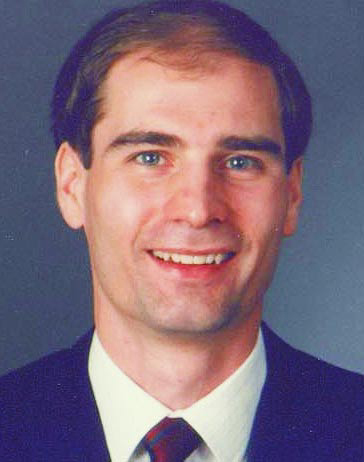Eric Thomas Swartz
DOI: 10.1063/1.1496388
Eric Thomas Swartz, the founder and vice president of technology at Desert Cryogenics in Tucson, Arizona, died on 8 September 2001, after a long and gallant battle against leukemia. With his passing, the low-temperature physics community lost one of its youngest and brightest scientists, and Eric’s family lost a devoted husband and dedicated father to four children.
Eric was born in Levittown, New Jersey, on 19 November 1959 and grew up in the Buffalo, New York, area. He began attending Rice University in 1977, graduating in three years with BS degrees in mathematics and physics. He then received an MS in mathematics from Rice in 1981 and a PhD in physics from Cornell University, under thesis adviser Robert O. Pohl, in 1986. Eric’s doctoral dissertation on thermal boundary resistance at cryogenic temperatures was published in the July 1989 issue of the Review of Modern Physics. This research extended the mathematical understanding of Kapitza resistance, and the review has been cited numerous times in the technical literature.
Eric was regarded as one of the top cryogenic system designers of his time. At age 17, he designed his first cryostat, a 4.5-K refrigerator, while working a summer job at Lake Shore Cryotronics in Westerville, Ohio. While a graduate student at Cornell, Eric developed an improved helium-3 cryostat that could be inserted into a standard helium-4 dewar, thus allowing routine measurements to be conducted at temperatures from 0.28 K to more than 400 K. This design and designs for helium-4 cryostats were published in the Review of Scientific Instruments.
In 1986, Eric began his technical career at Cryosystems in Tucson, where he designed cryogenic systems, including dilution systems,3 He and4 He cryostats, and closed-cycle systems. In 1996, he founded Desert Cryogenics and custom designed cryogenic systems for companies like TRW Inc, IBM Corp, and Hughes Technologies, as well as for numerous other US and worldwide organizations. Of particular importance are his designs for cryogenic multiple-probe systems for wafer sizes up to 8 inches in diameter, with zero stress on the wafer. The systems operated from 1.5 K to 400 K, at frequencies from 0 to 50 GHz, and in high magnetic fields. Researchers who used cryogenic technology in their work found it advantageous and illuminating to chat with Eric at the March meetings of the American Physical Society, whether at the Desert Cryogenics booth or elsewhere.
Soon after Desert Cryogenics was founded, Eric was diagnosed with aplastic anemia, which subsequently evolved into myelodysplasia and finally leukemia. Although hospitalized for much of the five years preceding his death, Eric ensured that his business continued to run successfully, directing company business using a cell phone and laptop computer when he was unable to be onsite. Desert Cryogenics was subsequently expanded under Eric’s vision.
Eric will be remembered for his thoughtfulness, integrity, and technical brilliance. He is missed by all who knew him and by the physics community to whom he made significant contributions in such a short time.

Eric Thomas Swartz

More about the Authors
Lawrence G. Rubin. Massachusetts Institute of Technology, Cambridge, US .
